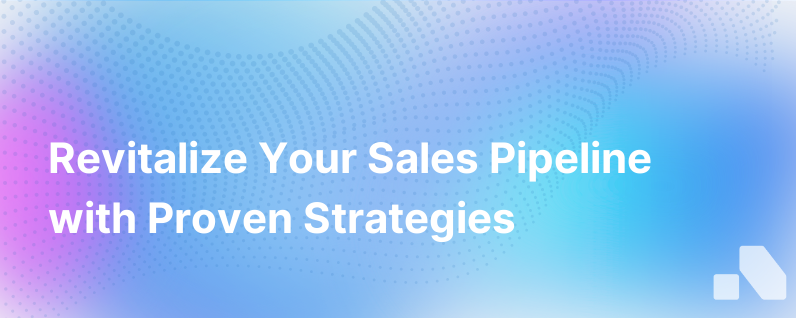Pipeline Stagnation
Published on November 8, 2023 by Sawyer Middeleer
Understanding and Overcoming Pipeline Stagnation for Sustained B2B Sales Growth
In the pulsating heart of every sales organization, the sales pipeline is the lifeblood that drives business growth. However, even the most diligently managed pipelines can face stagnation—akin to arterial blockages that threaten organizational vitality. Pipeline stagnation is characterized by leads that linger too long without advancing towards a deal, resulting in lower close rates and extended sales cycles. Left unchecked, it can erode morale, waste resources, and signal deep-rooted systemic issues.
In this article, we delve into the anatomy of pipeline stagnation, dissecting the potential causes and strategic ways to rejuvenate your sales flow for sustained B2B growth.
Diagnosing the Symptoms of Stagnation
Pipeline stagnation often manifests in several telltale symptoms that may subtly creep into your sales processes. These include a decreasing rate of leads converting to opportunities, a bloated pipeline with dated opportunities, and declining sales velocity—how quickly a lead moves from initial contact to closed deal.
Metrics You Cannot Ignore
Analyzing key performance indicators (KPIs) such as sales cycle lengths, win rates, and the ratio of closed-won to closed-lost deals offers a factual diagnosis of your pipeline's health. When these start deviating from the norm unfavorably, it signals the need for a scrutiny into your pipeline's integrity.
Investigating the Causes of Pipeline Stagnation
Understanding is the precursor to resolution, and acknowledging the multiple causes leading to stagnation is crucial.
Lack of Clear Qualification Criteria
Without clear lead qualification criteria, ill-fitting prospects can populate and clog your pipeline. Adopting a stringent qualification framework like BANT (Budget, Authority, Need, and Timeline) can help filter prospects that are more likely to convert.
Ineffective Sales Process
An inflexible or generic sales process, not attuned to your prospects' unique journeys, can halt deal progression. Customized sales processes catered to specific buyer personas ensure relatable and compelling engagement at each stage.
Insufficient Engagement Strategies
Engagement strategies that lack personalization fail to resonate, leading to disinterested prospects. Tailored content and value propositions tuned to specific pain points can reinvigorate stalled conversations.
Sales and Marketing Misalignment
Silos between sales and marketing hinder a unified go-to-market strategy. Bridging this gap ensures a seamless handoff of MQLs (marketing qualified leads) to SQLs (sales qualified leads) to maintain momentum.
Releasing the Pressure Points
Once the causes are identified, it's time to implement preventative measures and cures for a free-flowing pipeline.
Refining the Qualification Process
Ensure a rigorous qualification process that focuses on high-quality leads susceptible to nurturement and conversion. Reinforce the use of reliable lead scoring models and embrace predictive analytics to identify promising opportunities.
Revamping Your Sales Playbook
An agile sales playbook that reflects evolving market conditions and buyer behaviors can be a game-changer. Equip your sales team with dynamic scripts, objection handling techniques, and tactical approaches tailored for various scenarios within buyer journeys. Strive for a sales playbook that is a living document, frequently revised with the latest insights and strategies.
Sharpening Sales and Marketing Synergy
The alliance between sales and marketing should be an ongoing dialogue, ensuring both teams are synchronized on target personas, messaging, and content strategy—each sharing intelligence and insights to reinforce the other's tactics.
Boosting Sales Enablement Tools
Invest in contemporary sales enablement tools that deliver the right content at the right time. Technologies like CRM systems, email automation, and analytics platforms are essential in providing the insights required to move leads through the pipeline effectively.
Leveraging Predictive Analytics
Harness predictive analytics to anticipate and counteract sticking points. By analyzing historical data, you can predict future sales outcomes and trends that inform smarter, data-driven sales strategies.
Implementing the Cure
The final step is transforming insights into actions.
Conduct Regular Pipeline Reviews
Sales leaders should conduct comprehensive pipeline reviews to understand deal progression challenges. These reviews encourage accountability and enable tailored coaching to help representatives navigate complex sales hurdles.
Implement Continuous Training
Developing an ongoing training curriculum can keep sales reps agile and skilled in updated sales methodologies, ensuring they are well-equipped to handle prospect objections and advance deals.
Focus on Customer Success Stories
Regularly sharing customer success stories can illustrate the impact of your solution on real-world problems, building credibility and nudging indecisive prospects closer to a deal conclusion.
Encourage Cross-functional Communication
Foster an environment where sales, marketing, product development, and customer service openly communicate and share their customer interactions, enabling a 360-degree view of client expectations and experiences.
Keeping the Pipeline Flowing
With the corrective measures in place, your sales pipeline can regain its vitality and become more resilient against stagnation. It's crucial to maintain a proactive stance, constantly iterating your strategies to stay aligned with market dynamics and customer needs. Regular health checks, contextual engagement, and alignment across teams are your best bets in maintaining pipeline momentum.
The Aomni Edge
At the tail end of our exploration, it’s fair to bring Aomni into the picture as a remedy. Aomni's AI-powered platform can counteract pipeline stagnation by providing real-time account research, competitive insights, and personalized sales content, all of which can reinvigorate your pipeline and cut down on preparation time. It’s about empowering your sales team to sell smarter and faster, without the crippling effect of outdated information or misaligned strategies that often precipitate pipeline clogs.
In conclusion, transforming your static pipeline into a dynamic flow requires diligent analysis, robust strategies, and the right tools. By doing so, you position your B2B sales operations for steady, unhindered growth and long-term success.